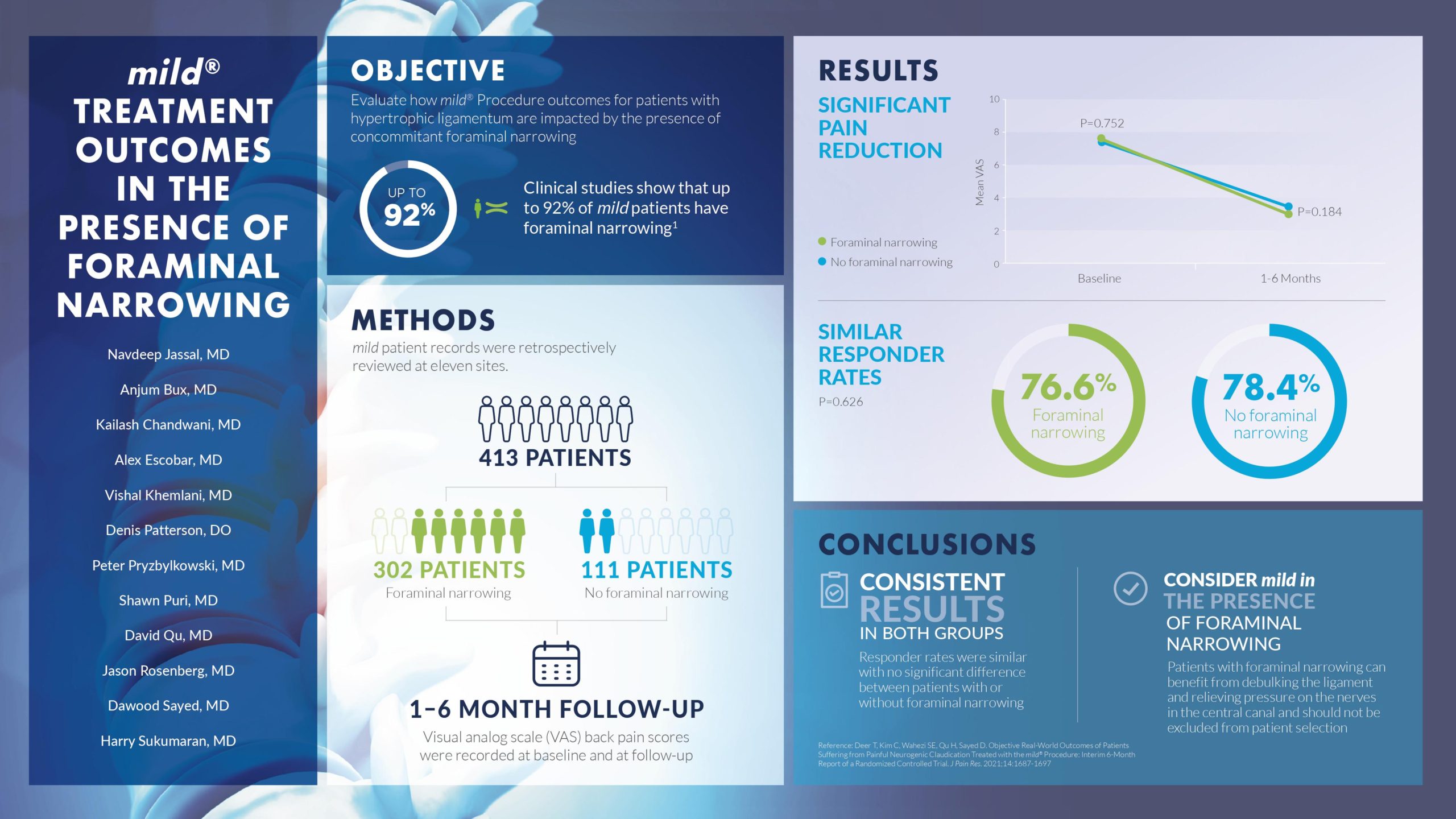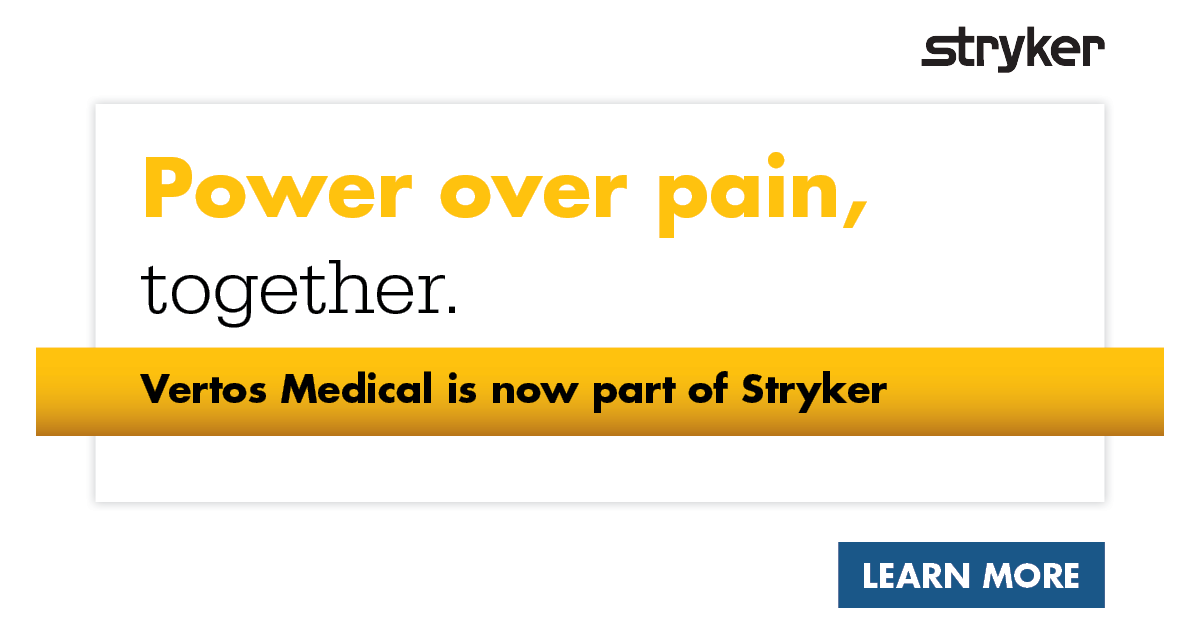NYNJ Abstract: mild® Treatment Outcomes in the Presence of Foraminal Narrowing
Author— Navdeep Singh Jassal, MD Published November 3, 2021
The following study, “mild® Treatment Outcomes in the Presence of Foraminal Narrowing,” evaluates how the mild® Procedure outcomes for patients with hypertrophic ligamentum flavum (HLF) are impacted by the presence of concomitant foraminal narrowing. 413 patients from 11 sites were retrospectively reviewed, with VAS scores compared at baseline and follow-up (1-6 months) within each group over time and between groups. Responder rates were 76.6% for patients with foraminal narrowing, and 78.4% for patients without. Though the amount of pain improvement between groups was not significantly different, this study confirms that by debulking the HLF and reducing compression on the nerves, patients with foraminal narrowing can benefit from a relief in pressure and should not be excluded from patient selection. View the abstract poster below to learn more about the results.

Watch Dr. Navdeep Jassal present his abstract from the New York & New Jersey Pain Medicine Symposium 2021 Conference, where he reviews the data and shares why mild® should be considered for patients impacted by the presence of foraminal narrowing as an adjunctive spinal comorbidity.
Are you ready to put your lumbar spinal stenosis patients on the path to long-term relief? Contact Vertos Medical and discover why leading interventionalists offer mild® in their practice.
Navdeep Jassal, MD (00:00)
My name is Navdeep Jassal. I practice in Lakeland, Florida as an Interventional Pain Physician, and my primary specialty is Physiatry. I’m going to talk a little bit about a poster presentation that will be presented at the New York and New Jersey meeting, talking specifically about the mild® treatment outcomes in patients with presence of foraminal narrowing.
So the onus for this poster was to really evaluate how the mild® Procedure, how their outcomes are, for patients with not only hypertrophic ligamentum flavum, but also how, when you do this mild® Procedure, patients are impacted even with the presence of foraminal narrowing. And we obviously know that this procedure is indicated to those with patients with LSS, with neurogenic claudication, we’re going to look for the ligament. We’re going to look for at least 2.5 millimeters of hypertrophic ligamentum flavum to debulk, but we want to make sure that we understand that physicians aren’t really excluding patients with also other co-factors such as foraminal narrowing. Because oftentimes we realize when you exclude such a patient population, you’re really excluding a patient to receive an outstanding therapy that’s not only safe, but efficacious. And here we actually show a poster to show those types of results.
So we have mild® patients’ recordings that were done across 11 sites or 11 centers with outstanding colleagues. We studied 413 patients retrospectively and out of these 413 patients, we saw 302 patients with foraminal narrowing, and we saw 111 patients with no foraminal narrowing. So if you think about the data, this really shows a typical type of patient population that presents with LSS, those with not just central canal stenosis, but also patients with co-factors that presents with neuroforaminal stenosis, those with facet hypertrophy, but really we’re going to really show that patients actually present, in fact, 302, presents with foraminal narrowing. And we study these patients out, you know, 1-6 months and we followed them up from a VAS (or visual analog scale) perspective. And these were recorded and compared to their baseline findings.
(02:18) From our baseline findings, we saw that these patients typically hovered in the 8 out of 10 or a VAS score of 8 out of 10. And we saw a significant improvement, at least a drop of about 50%. So from an 8 to a 4, about 1-6 months out. What was very interesting about this data specifically, was that there was really no significant difference in terms of the responder rate between those patients that received the treatment of the mild® with those that had foraminal narrowing versus those that did not have foraminal narrowing. In fact, those that had foraminal narrowing in our study were about 76.6% that actually had the responder rate. And then 78.4% that did not have foraminal narrowing had a good responder rate as well. So you can see, there was a very similar responder rate from those that had versus those that did not have foraminal narrowing.
And so from a conclusion standpoint, I really want to make this clear that because both responder rates were similar with no significant difference between patients with or without foraminal narrowing that underwent the mild® Procedure with a significant VAS pain reduction. I really want to hit home that patients with foraminal narrowing can really benefit, from the debulkment of the ligament. And, I think the hypothesis is that when we do this decompression or posterior decompression with the mild® Procedure, we are in fact relieving pressure on the nerves in the central canal. And so again, if we go back to a simple phenomena of a small change in volume is a large change in pressure, we can see how these patients do really well. So again, really trying to hit home that those patients with foraminal narrowing should not be excluded from such a safe and efficacious procedure for their LSS with neurogenic claudication symptoms.
So I think this data is tremendous because it should help those physicians that are skeptical about treating the mild® Procedure for those patients with co-factors. I know I talk to a lot of colleagues who are questioning whether they should offer a mild® Procedure with patients with not only the LFH (ligamentum flavum hypertrophy), but with co-factors of facet hypertrophy, or foraminal stenosis. And I would really challenge them to look at the data and show that, yes you should. If patients have foraminal stenosis or foraminal narrowing, you should treat the patient with the mild® Procedure if they are following signs and symptoms of LSS with neurogenic claudication, and they fit the criteria of something that you can debulk posteriorly with the mild® Procedure. I think it’s an incredibly safe procedure. We’ve proven time and time again, that it’s efficacious from RCTs. And I think this data will challenge you to think more about utilizing the mild® therapy for these patients with LSS.
Benyamin RM, Staats PS, MiDAS ENCORE Investigators. mild® is an effective treatment for lumbar spinal stenosis with neurogenic claudication: MiDAS ENCORE Randomized Controlled Trial. Pain Physician. 2016;19(4):229-242.
Mekhail N, Costandi S, Abraham B, Samuel SW. Functional and patient-reported outcomes in symptomatic lumbar spinal stenosis following percutaneous decompression. Pain Pract. 2012;12(6):417-425. doi:10.1111/j.1533-2500.2012.00565.x.
2012 data from Health Market Sciences report for Vertos Medical 2013.
Data on file with Vertos Medical.
Staats PS, Chafin TB, Golvac S, et al. Long-term safety and efficacy of minimally invasive lumbar decompression procedure for the treatment of lumbar spinal stenosis with neurogenic claudication: 2-year results of MiDAS ENCORE. Reg Anesth Pain Med. 2018;43:789-794. doi:10.1097/AAP.0000000000000868.
Based on mild® Procedure data collected in all clinical studies. Major complications are defined as dural tear and blood loss requiring transfusion.
MiDAS ENCORE responder data. On file with Vertos Medical.
Jain S, Deer TR, Sayed D, et al. Minimally invasive lumbar decompression: a review of indications, techniques, efficacy and safety. Pain Manag. 2020;10(5). https://doi.org/10.2217/pmt-2020-0037. Accessed June 1, 2020.
Deer TR, Grider JS, Pope JE, et al. The MIST Guidelines: the Lumbar Spinal Stenosis Consensus Group guidelines for minimally invasive spine treatment. Pain Pract. 2019;19(3)250-274. doi:10.1111/papr.12744.
Hansson T, Suzuki N, Hebelka H, Gaulitz A. The narrowing of the lumbar spinal canal during loaded MRI: the effects of the disc and ligamentum flavum. Eur Spine J. 2009;18(5):679-686. doi:10.1007/s00586-009-0919-7.
Treatment options shown are commonly offered once conservative therapies (e.g., physical therapy, pain medications, chiropractic) are not providing adequate relief. This is not intended to be a complete list of all treatments available. Doctors typically recommend treatments based on their safety profile, typically prioritizing low risk/less aggressive procedures before higher risk/more aggressive procedures, but will determine which treatments are appropriate for their patients.
The mild® Procedure is a minimally invasive treatment for lumbar spinal stenosis. As with most surgical procedures, serious adverse events, some of which can be fatal, can occur, including heart attack, cardiac arrest (heart stops beating), stroke, and embolism (blood or fat that migrates to the lungs or heart). Other risks include infection and bleeding, spinal cord and nerve injury that can, in rare instances, cause paralysis. This procedure is not for everyone. Physicians should discuss potential risks with patients. For complete information regarding indications for use, warnings, precautions, and methods of use, please reference the devices’ Instructions for Use.
Patient stories on this website reflect the results experienced by individuals who have undergone the mild® Procedure. Patients are not compensated for their testimonial. The mild® Procedure is intended to treat lumbar spinal stenosis (LSS) caused by ligamentum flavum hypertrophy. Although patients may experience relief from the procedure, individual results may vary. Individuals may have symptoms persist or evolve or other conditions that require ongoing medication or additional treatments. Please consult with your doctor to determine if this procedure is right for you.
Reimbursement, especially coding, is dynamic and changes every year. Laws and regulations involving reimbursement are also complex and change frequently. Providers are responsible for determining medical necessity and reporting the codes that accurately describe the work that is done and the products and procedures that are furnished to patients. For this reason, Vertos Medical strongly recommends that you consult with your payers, your specialty society, or the AMA CPT regarding coding, coverage and payment.
Vertos Medical cannot guarantee coding, coverage, or payment for products or procedures. View our Billing Guide.
Vertos is an equal employment opportunity workplace committed to pursuing and hiring a diverse workforce. We strive to grow our team with highly skilled people who share our culture and values. All qualified applicants will receive consideration for employment without regard to sex, age, color, race, religion, marital status, national origin, ancestry, sexual orientation, gender identity, physical & mental disability, medical condition, genetic information, veteran status, or any other basis protected by federal, state or local law.
Hall S, Bartleson JD, Onofrio BM, Baker HL Jr, Okazaki H, O’Duffy JD. Lumbar spinal stenosis. Clinical features, diagnostic procedures, and results of surgical treatment in 68 patients. Ann Intern Med. 1985;103(2):271-275. doi:10.7326/0003-4819-103-2-271.
Kalichman L, Cole R, Kim DH, et al. Spinal stenosis prevalence & association with symptoms: The Framingham Study. Spine J. 2009;9(7):545-550. doi:10.1016/j.spinee.2009.03.005.
Fukusaki M, Kobayashi I, Hara T, Sumikawa K. Symptoms of spinal stenosis do not improve after epidural steroid injection. Clin J Pain. 1998;14(2):148-151. doi:10.1097/00002508-199806000-00010.
Mekhail N, Costandi S, Nageeb G, Ekladios C, Saied O. The durability of minimally invasive lumbar decompression procedure in patients with symptomatic lumbar spinal stenosis: Long-term follow-up [published online ahead of print, 2021 May 4]. Pain Pract. 2021;10.1111/papr.13020. doi:10.1111/papr.13020
Friedly JL, Comstock BA, Turner JA, et al. Long-Term Effects of Repeated Injections of Local Anesthetic With or Without Corticosteroid for Lumbar Spinal Stenosis: A Randomized Trial. Arch Phys Med Rehabil. 2017;98(8):1499-1507.e2. doi:10.1016/j.apmr.2017.02.029
Pope J, Deer TR, Falowski SM. A retrospective, single-center, quantitative analysis of adverse events in patients undergoing spinal stenosis with neurogenic claudication using a novel percutaneous direct lumbar decompression strategy. J Pain Res. 2021;14:1909-1913. doi: 10.2147/JPR.S304997
Pryzbylkowski P, Bux A, Chandwani K, et al. Minimally invasive direct decompression for lumbar spinal stenosis: impact of multiple prior epidural steroid injections [published online ahead of print, 2021 Aug 4]. Pain Manag. 2021;10.2217/pmt-2021-0056. doi:10.2217/pmt-2021-0056
Abstract presented at: American Society of Pain and Neuroscience Annual Conference; July 22-25, 2021; Miami Beach, FL.
Mobility Matters: Low Back Pain in America, Harris Poll Survey, 2022. View data and full summary here.
Deer TR, Grider JS, Pope JE, et al. Best Practices for Minimally Invasive Lumbar Spinal Stenosis Treatment 2.0 (MIST): Consensus Guidance from the American Society of Pain and Neuroscience (ASPN). J Pain Res. 2022;15:1325-1354. Published 2022 May 5. doi:10.2147/JPR.S355285.

